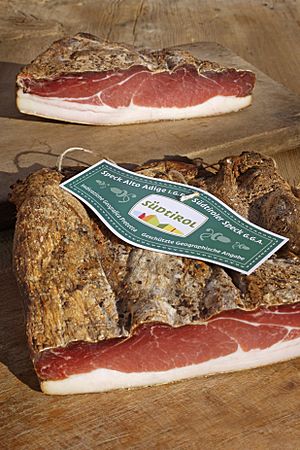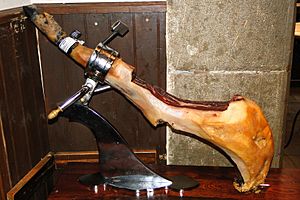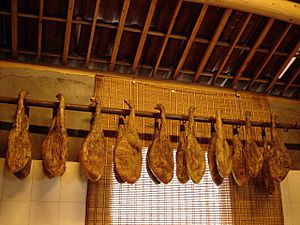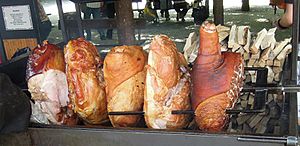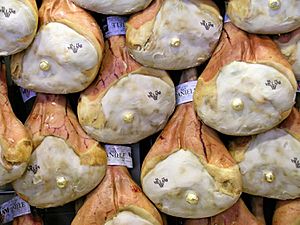List of hams facts for kids
Ham is a popular food made from pork, usually from the hind leg of a pig. To make ham, the meat is preserved in different ways. This can include salting, smoking, or curing (which means treating it with salt, sugar, or other ingredients).
People around the world make many kinds of ham. Some hams are very famous and special to certain regions, like Westphalian ham from Germany or jamón serrano from Spain. Many hams also have special protection, meaning they can only be made in certain places using traditional methods. This helps keep their unique quality and flavor.
Contents
Different Hams from Around the World
Bulgaria
- Elenski but is a special dry-cured ham from the town of Elena in northern Bulgaria. It has a unique taste and can be stored for many years. This is thanks to the special way it's made and the climate in the Stara Planina mountains where Elena is located.
China
- Anfu ham is a dry-cured ham from Anfu, Jiangxi, China. People have been making it since the ancient Qin Dynasty. It's eaten on its own or used to add flavor to many different dishes.
- Jinhua ham is a famous dry-cured ham from Jinhua, in China's Zhejiang province. This ham is often used in Chinese cooking to flavor stews and braised foods. It's also great for making rich broths and soups. It's known as "the most prized ham in all of China."
- Rugao ham is another dry-cured ham from Jiangsu province, China. It was first made in 1851. Rugao ham comes in many different flavors, colors, and sizes.
- Xuanwei ham comes from the Qujing area in Yunnan province, China. This ham has a long history, going back over 250 years to 1766. It became very popular after it was first mass-produced in 1909. Like other Chinese hams, it's used to add flavor to various dishes.
Czech Republic
- Prague ham is a special ham from Prague in the Bohemia region of the Czech Republic. It is cured in a salty water mix (brine), then cooked, and lightly smoked over beechwood. It's usually sold without the bone.
England
- York ham started in Yorkshire, England, but is now made in other places too. It's a dry-cured ham, but unlike some others, it's always eaten cooked. Many people think it's one of the best hams you can find.
- Wiltshire cure ham is a traditional ham from Wiltshire, England, known for its historical curing method.
France
- Jambon de Bayonne is a cured ham named after the old port city of Bayonne in south-west France. This city is in both the Basque Country and Gascony regions. It has a special status that protects its name and production methods.
- Jambon noir de Bigorre is made from black Gascon pigs.
- Jambon de kintoa is made from Basque pigs.
- Jambon de Corse is made from black Nustrale pigs.
- Jambon sec des Ardennes is another famous French ham.
- Torchon ham is special because it's wrapped in a cloth while it cooks. This gives it a better flavor and texture.
Germany
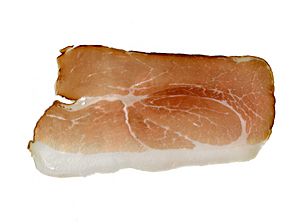
Sliced Black Forest ham
- Ammerländer Schinken is a dry-cured and often smoked ham from the Ammerland area of northern Germany. It has a special protected status under European law.
- Black Forest ham is a type of dry-cured, smoked ham. It's made in the Black Forest region of Germany.
- Westphalian ham comes from pigs that eat acorns in the forests of Westphalia, Germany. The meat is dry-cured and then smoked over a mix of beechwood and juniper branches.
Ireland
- Limerick ham is a special way of preparing ham that started in County Limerick, Ireland. It's a traditional Irish dish.
Italy
- Prosciutto is a famous Italian dry-cured ham. It's usually sliced very thin and served uncooked. In Italian, this style is called prosciutto crudo.
- Crudo di Cuneo is a type of prosciutto from Piedmont.
- Prosciutto di Parma is a very well-known prosciutto from Emilia-Romagna.
- Prosciutto di San Daniele comes from Friuli-Venezia Giulia.
- Prosciutto toscano is from Tuscany.
- Speck Alto Adige is a dry-cured, lightly smoked ham from South Tyrol, northern Italy. Its production is protected by European Union rules. When people say "speck" in English-speaking countries, they often mean this Italian ham.
- Tyrolean Speck is a boneless ham with a special juniper flavor. It comes from Tyrol, a historical region that is now partly in Italy. People have been making Tyrolean Speck since the early 13th century.
- Vallée d’Aoste Jambon de Bosses is a spicy, cured ham from Saint-Rhémy-en-Bosses in the Aosta Valley in Italy. It's one of the region's special foods and has protected status from the European Union.
Luxembourg
- Éisleker ham, also called "Oesling ham," is a specialty from the Oesling region in northern Luxembourg. It's made from the hind legs of pigs. Traditionally, the hams were marinated in herbs and vinegar, then hung in a chimney for a long time to be cold smoked. Today, the meat is cured in a salty water mix (brine) for two weeks, then smoked over beech and oak wood chips for about a week.
Montenegro
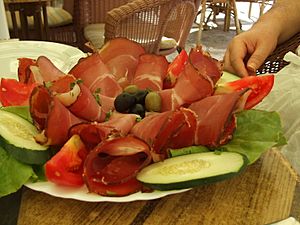
Sliced njeguški pršut
- Njeguški pršut is a dry-cured ham from Njeguši, a village in Montenegro. It's served uncooked, similar to Italian prosciutto.
Portugal
- Presunto is a dry-cured ham from Portugal. It's very similar to Spanish jamón or Italian prosciutto crudo.
Spain

Sliced jamón serrano
- Jamón serrano is a dry-cured ham and one of the most famous foods in Spanish cuisine. It has a special status that protects its traditional way of being made.
- Jamón ibérico is a type of Jamón made in Spain and Portugal. It comes from special black Iberian pigs, not white breeds. Some of the most expensive hams in the world are Jamón ibérico.
- Lacón Gallego is a dried ham product from Galicia. It also has a special protected status under European law.
United States
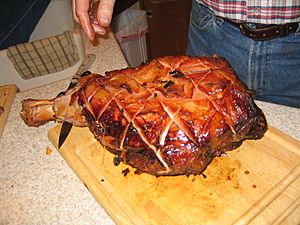
Baked country ham
- Chipped chopped ham is a processed ham luncheon meat made from chopped ham. It's a mix of ham pieces and seasonings, ground together and shaped into loaves.
- City ham is the name for hams that are cured in a salty water mix (brine) but not dry-cured or dried. They need to be kept in the refrigerator. In many parts of the U.S., people just call this "ham."
- Country ham is a type of dry-cured ham. This method of curing and smoking is common in the southeastern U.S. states like North Carolina, South Carolina, Tennessee, Virginia, and Kentucky.
- Glazed ham in the U.S. is coated with a sweet or spiced sugar solution before it's cooked. This gives it a shiny, flavorful crust.
- Smithfield ham is a specific type of country ham that is finished curing in the town of Smithfield, Virginia.
Wales
- Carmarthen Ham is an air-dried ham from Wales. It's cured in the traditional Welsh farmhouse way and has a protected status.
Images for kids
-
Anfu ham drying on racks
-
Lacón Gallego at a market
-
Sliced Speck Alto Adige PGI
See also
- Ham hock
- Ham sausage
- List of dried foods
- List of ham dishes
- List of pork dishes
- List of smoked foods
- Turkey ham – a processed food made from cooked or cured turkey meat, shaped like a ham.

All content from Kiddle encyclopedia articles (including the article images and facts) can be freely used under Attribution-ShareAlike license, unless stated otherwise. Cite this article:
List of hams Facts for Kids. Kiddle Encyclopedia.

